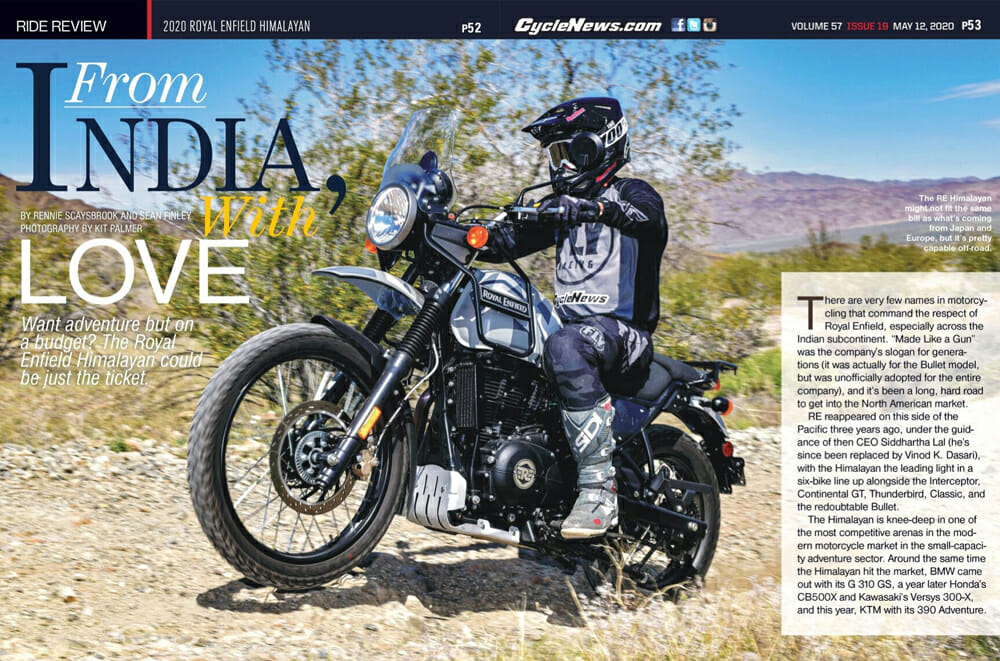Sean Finley | May 15, 2020
Want adventure but on a budget? The Royal Enfield Himalayan could be just the ticket.
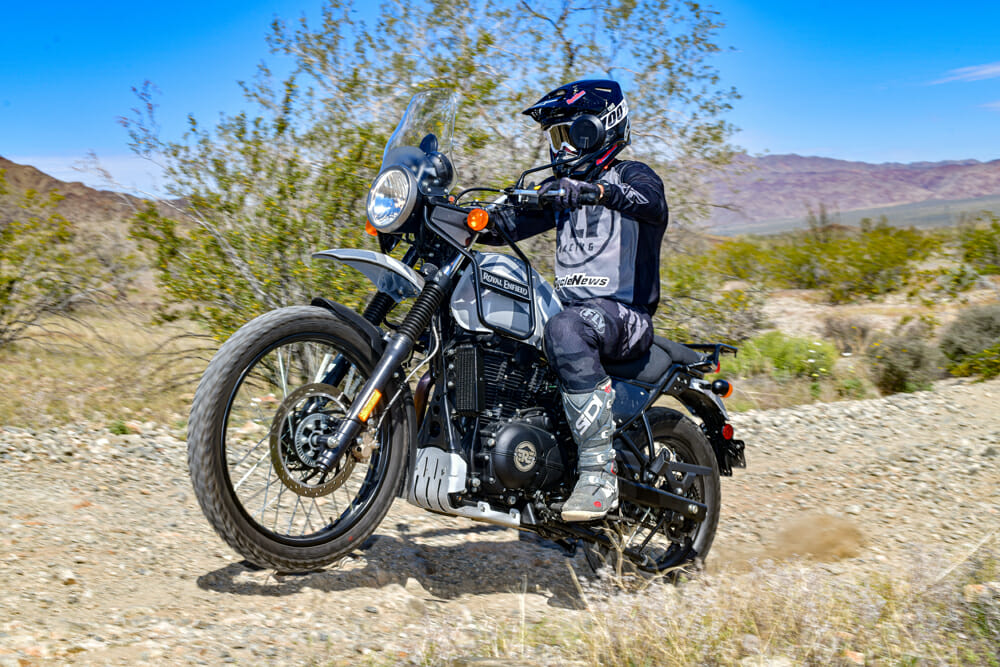 The RE Himalayan might not fit the same bill as what’s coming from Japan and Europe, but it’s pretty capable off-road.
The RE Himalayan might not fit the same bill as what’s coming from Japan and Europe, but it’s pretty capable off-road.
By Rennie Scaysbrook and Sean Finley | Photography by Kit Palmer
There are very few names in motorcycling that command the respect of Royal Enfield, especially across the Indian subcontinent. “Made Like a Gun” was the company’s slogan for generations (it was actually for the Bullet model, but was unofficially adopted for the entire company), and it’s been a long, hard road to get into the North American market.
RE reappeared on this side of the Pacific three years ago, under the guidance of then CEO Siddhartha Lal (he’s since been replaced by Vinod K. Dasari), with the Himalayan the leading light in a six-bike line up alongside the Interceptor, Continental GT, Thunderbird, Classic, and the redoubtable Bullet.
The Himalayan is knee-deep in one of the most competitive arenas in the modern motorcycle market in the small-capacity adventure sector. Around the same time the Himalayan hit the market, BMW came out with its G 310 GS, a year later Honda’s CB500X and Kawasaki’s Versys 300-X, and this year, KTM with its 390 Adventure.
It could be argued, especially in the case of the BMW and the KTM, that these bikes are aimed more at the performance off-road sector, while the Himalayan takes a more relaxed approach to adventure touring. It’s a bike designed to take on the Himalayas in comfort—ready to race; this is not.
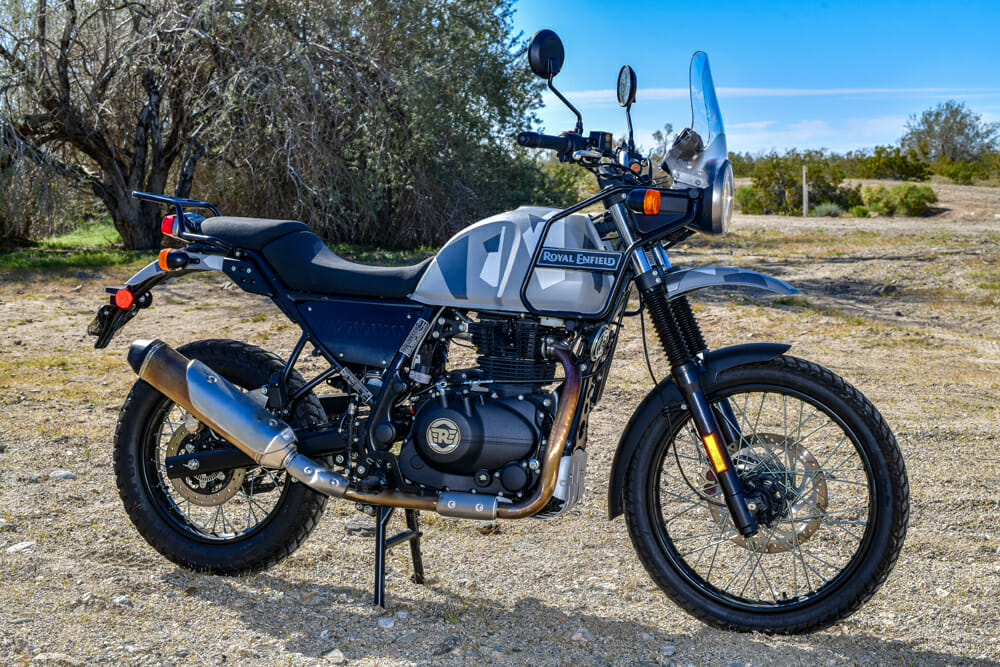 Everything here comes standard, including the high screen and skid-plate. Not bad for under $5K.
Everything here comes standard, including the high screen and skid-plate. Not bad for under $5K.
Powering the Himalayan is the single-cylinder 410 LS motor (LS standing for Long Stroke), pumping out a meager 24 horsepower, and 25 lb-ft of torque in a package weighing a measured (by us) 430 pounds. Don’t laugh, the numbers may look like they’re lopsided to the obese, but in practice, the Himalayan produces enough forward movement to at least keep you interested.
Fuel injection is now commonplace—as it is across the entire RE range—marking the first time the former British brand has strayed from carburetors. Interestingly, the motor runs the old-school screw-and-locknut design for the valves, meaning you need to adjust the valves every 3000 miles. This will be an instant turn off for many an aspiring buyer, as 3000 miles will pass very quickly if you’re out riding each week, and ripping open the top of a motor is not on many people’s want list.
On the plus side, the valve adjustment is dead easy once you’ve done it a couple of times, meaning you can now carry out your own basic maintenance of oil, filter and valves without taking it to a dealer. Get used to changing a chain and sprocket, and you may never need a dealer again.
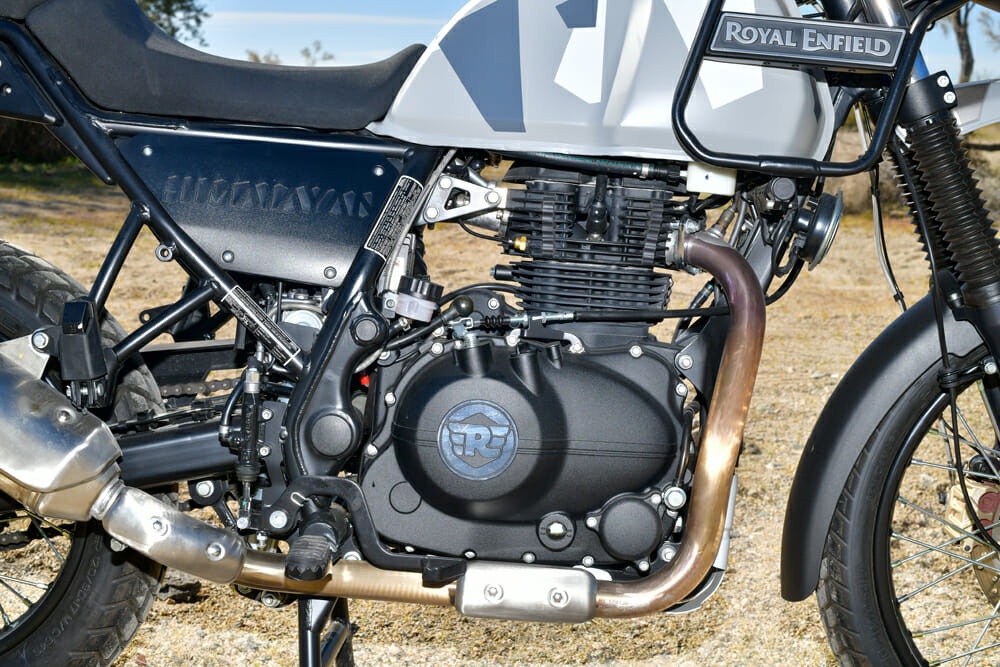 That little single won’t pull your arms out of your sockets with only 24 horsepower on tap, but it’s a smooth little motor that’s simple to work on.
That little single won’t pull your arms out of your sockets with only 24 horsepower on tap, but it’s a smooth little motor that’s simple to work on.
The motor sits inside a chassis crafted by Harris Performance in the UK, which is where much of the development work was carried out. Why does Harris Performance sound familiar? Those with good racing memories will remember Harris as the builder of the chassis many of the 500cc Grand Prix/MotoGP privateer teams used in the 1990s. Remember the WCM MotoGP bike of 2003? Harris built that, too.
Harris thus knows how to build a good chassis, and with lead development rider, former 500cc racer and motorcycle journalist, Australian Paul Young, they decided on the split cradle frame that, yes, cradles the bottom of the motor and helps provide an extra layer of protection.
Part of the standard fitment with a Himalayan is the skid-plate (well done, RE), and the rear luggage rack—we didn’t test the bike with the pannier setup, but from what we’ve seen elsewhere, the luggage system has been well integrated into the motorcycle’s design.
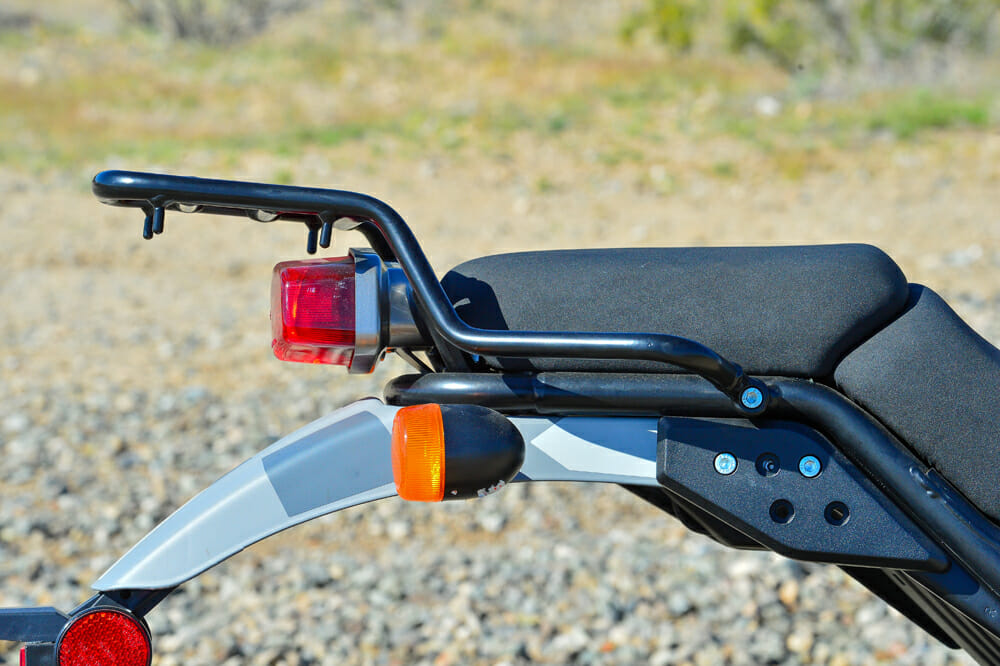 The passenger is perched quite high, which limits the rider’s ability to scooch back if needed. Luggage rack is standard fitment.
The passenger is perched quite high, which limits the rider’s ability to scooch back if needed. Luggage rack is standard fitment.
On the suspension side, the 21-inch front wheel slots between two un-adjustable 41mm forks (resplendent with rubber gaiters), and, for the first time on a RE, monoshock rear suspension with a linkage helps keep the 17-inch rear wheel in check.
With 7.9 and 7.1 inches of front/rear travel, respectively, and 8.7 inches of ground clearance, you can take the Himalayan places you’d not think possible, so long as you don’t go crashing over rocks and blowing through the admittedly very soft suspension.
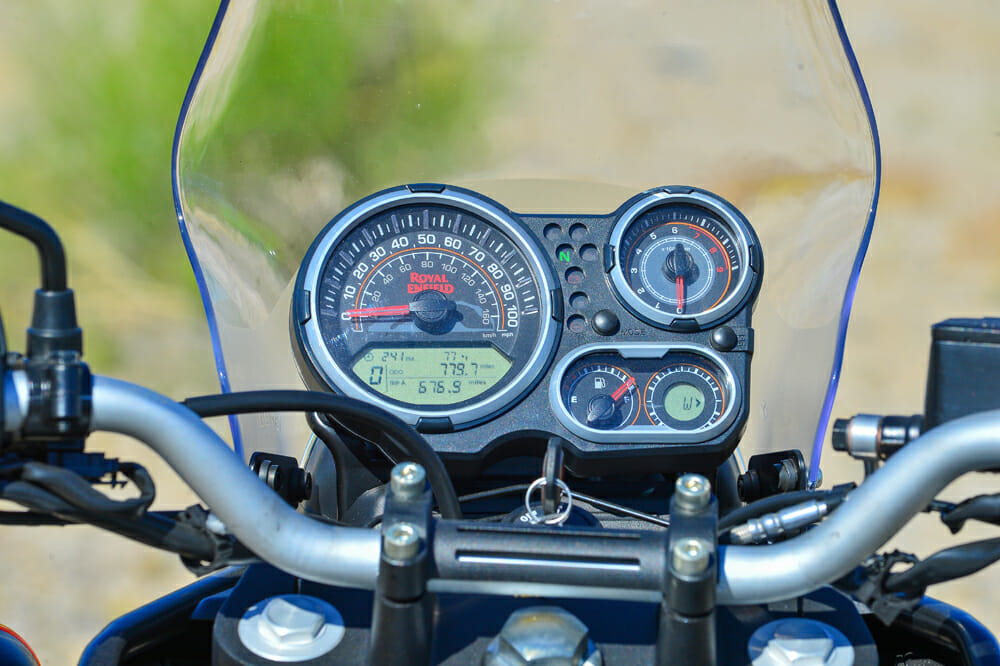 The dash is a mix of old and new, although the speed readout is a little cramped with both mph and km/h.
The dash is a mix of old and new, although the speed readout is a little cramped with both mph and km/h.
Part of the appeal with the Himalayan is the styling, which is a complete departure from what’s on offer from the Japanese and European counterparts. The Himalayan is far more sedate, with a deep-dish seat and perched pillion, crash bars adorning the tank, stumpy front fender and high windscreen, semi-off-road Pirelli MT60 rubber and tiny two-piston front brake. There’s no traction control, although the ABS is annoyingly unable to be switched off thanks to the Euro 5 mandate that says all bikes sold in Europe from 2020 onwards must have ABS that can’t be switched off.
But what’s it like to ride? The Cycle News boss man and hardcore ADV rider, Sean Finley, grabbed the key to find out.
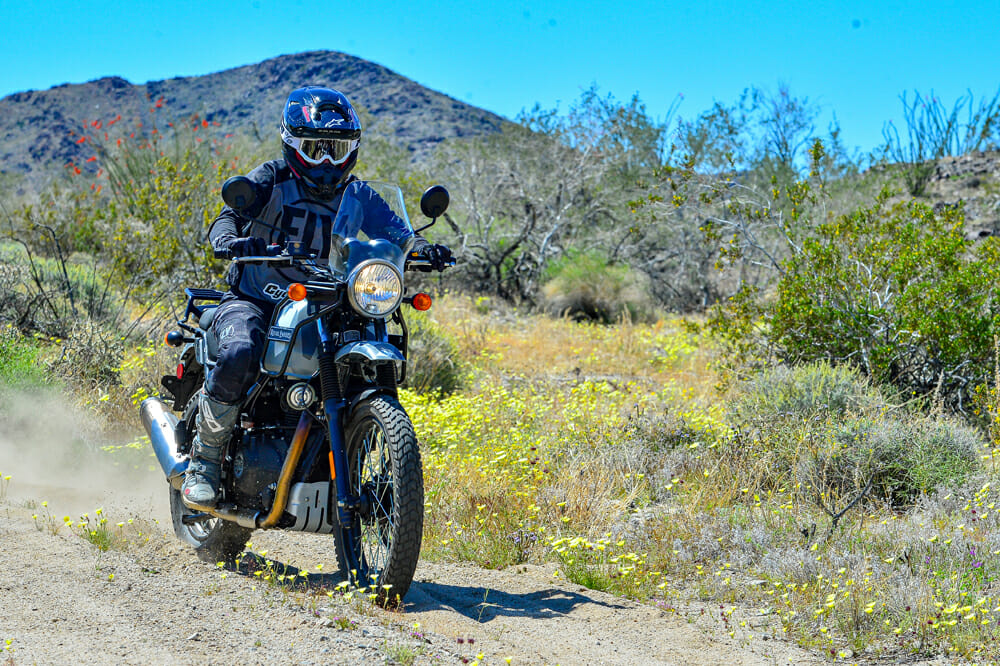
2020 Royal Enfield Himalayan | From The Hot Seat
With a price tag of just $4749, most experienced riders would likely think that the Royal Enfield Himalayan is not a very capable motorcycle. After hearing mostly positive feedback about the bikes, I was looking forward to the opportunity to try it for myself.
I have owned multiple Adventure bikes that cost two to three times as much, and they are certainly far more capable in terms of performance and technical features, but despite that, I came away impressed with the Himalayan. Part of the charm is the simplicity, and despite that simplicity, it does everything it needs to do to take you out for a great adventure on two wheels.
The first thing I noticed is that the riding position, seat, and simple windscreen provide a very comfortable ride. Everything about the cockpit makes this a bike you can ride comfortably for hours, although the seat foam is a little soft and seems that it could break down over time.
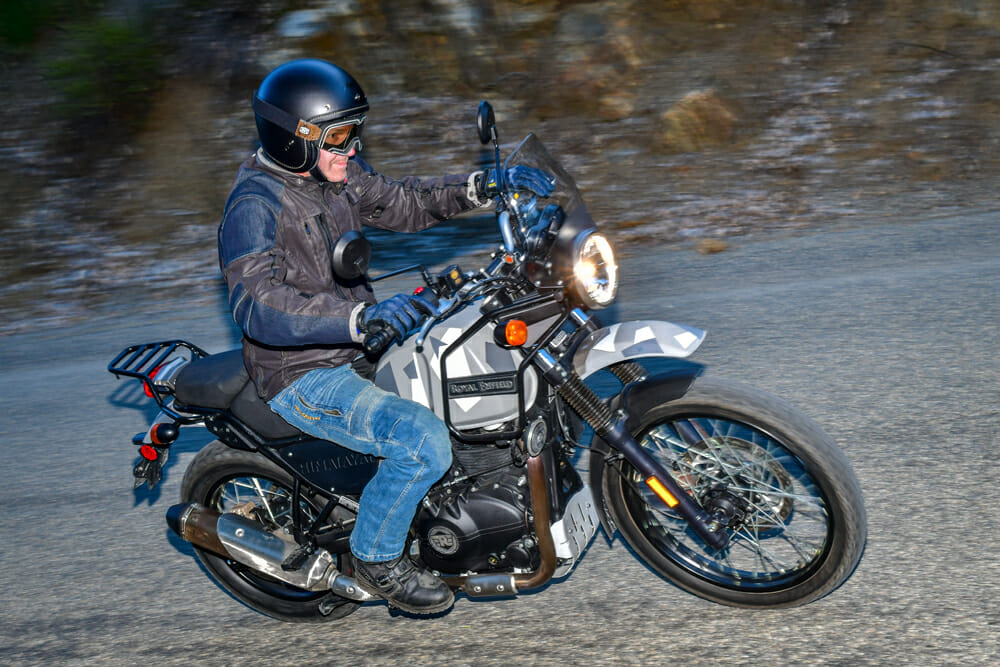 Soft suspension makes the Enfield a surprising pleasure on road.
Soft suspension makes the Enfield a surprising pleasure on road.
The suspension works well on the road and is not too bad on dirt roads. It is equally comfortable for standing up in off-road terrain. If I had to be picky, the rear shock is a little springy compared to the forks, but that is only noticeable if you are on pretty rough terrain.
The 7.9 and 7.0 inches of front/rear travel, respectively, combined with 8.7 inches of ground clearance and a standard aluminum skid-plate, make it pretty capable in the dirt, and shorter or less experienced riders will like the 31.5-inch seat height.
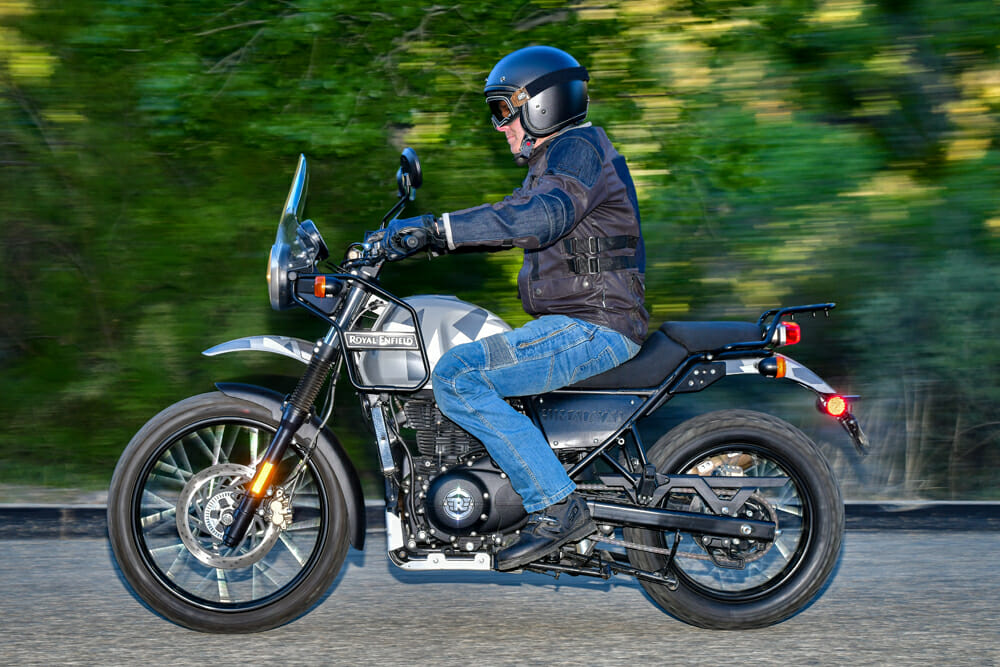 Comfort is a strong suit of the 2020 Royal Enfield Himalayan.
Comfort is a strong suit of the 2020 Royal Enfield Himalayan.
The relatively narrow seat compared to many larger bikes also helps to make it easy to reach the ground, and the standard Pirelli MT60 tires are a good choice for this bike as they work well on both the road and dirt.
The 411cc single-cylinder, fuel-injected engine will not win a drag race against many bikes, but like the rest of the bike, it gets the job done. In fact, it has decent torque for the size/displacement. It has a real-world top speed of about 75 miles per hour (we got a max speed of 80 miles per hour on our GPS), so it would be frustrating to try to keep up with a group of buddies on faster bikes. If you are not in a hurry or riding with other riders on smaller-displacement bikes, you will be just fine, but you will need to plan out any overtaking moves on the road.
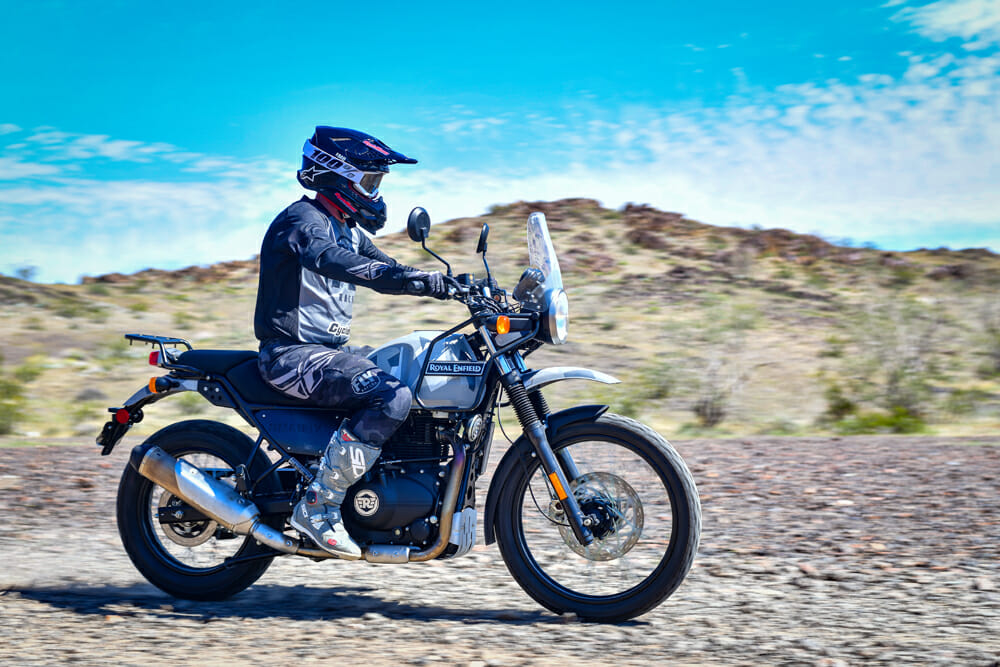 This terrain is about as rugged as you’ll want to take the Himalayan on, but that’s okay
This terrain is about as rugged as you’ll want to take the Himalayan on, but that’s okay
Kudos to Royal Enfield for using a counterbalancer, as the vibration is minimal all the way up to the 6500-rpm redline. Speaking of the redline, the simple analog speedo, fuel gauge and tach fit the retro look of the bike, but the dash includes a digital gear indicator, clock, odometer, trip and air temperature. The five-speed transmission shifts smoothly, although the clutch will heat up a bit (and it’s only adjustable down at the motor), allowing for more play in the clutch lever if you abuse it, but it was fine once the bike cooled down.
The Himalayan is not light by any means, but it mostly carries the weight well both on the street and dirt.
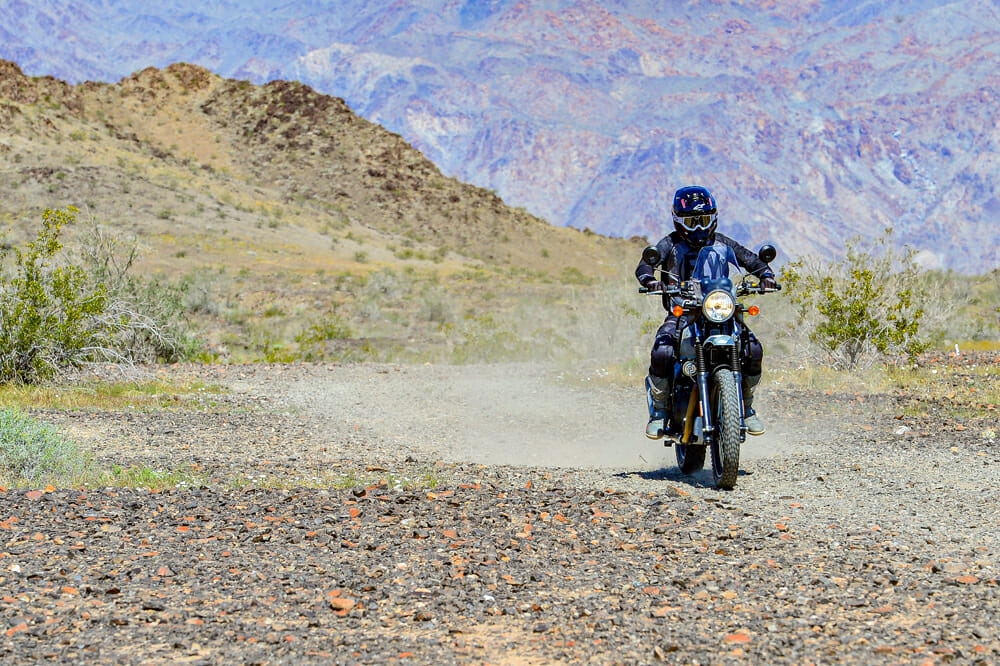 Plan on 200-plus miles between fill-ups! That is comforting to know when you’re out here.
Plan on 200-plus miles between fill-ups! That is comforting to know when you’re out here.
Despite steel-braided brake lines and a solid feel at the lever, the front brake on the Himalayan has very little power. Even though it has front and rear ABS, the front ABS never really feels like it kicks in at all.
The rear brake works fine, although the ABS activates a bit too easily, especially on the dirt. As mentioned, the ABS cannot be turned off, but we found a few hacks online to pull the fuse or add a switch to it, and this is something we would do if we owned the bike.
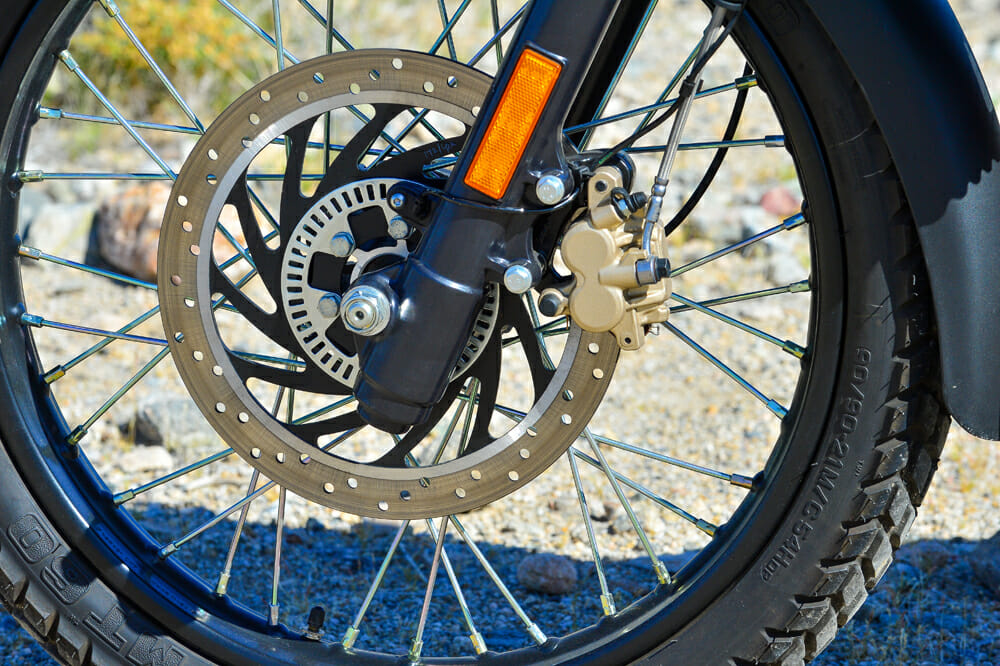 The front brake offers very little feel and power.
The front brake offers very little feel and power.
A few requirements for an adventure bike are the fuel range to get away from the city, and the ability to carry luggage for more serious adventures. We averaged 55 mpg even with aggressive riding, so the nearly four-gallon fuel tank will comfortably go 200 miles between fill-ups. It comes standard with a rear rack, and the front bars that hold the headlight and instruments are designed to hold luggage or additional fuel cans. The tail section is also designed for mounting luggage, and, as a bonus, it comes with a centerstand, which should be a standard feature for an ADV bike but is conspicuously missing from many.
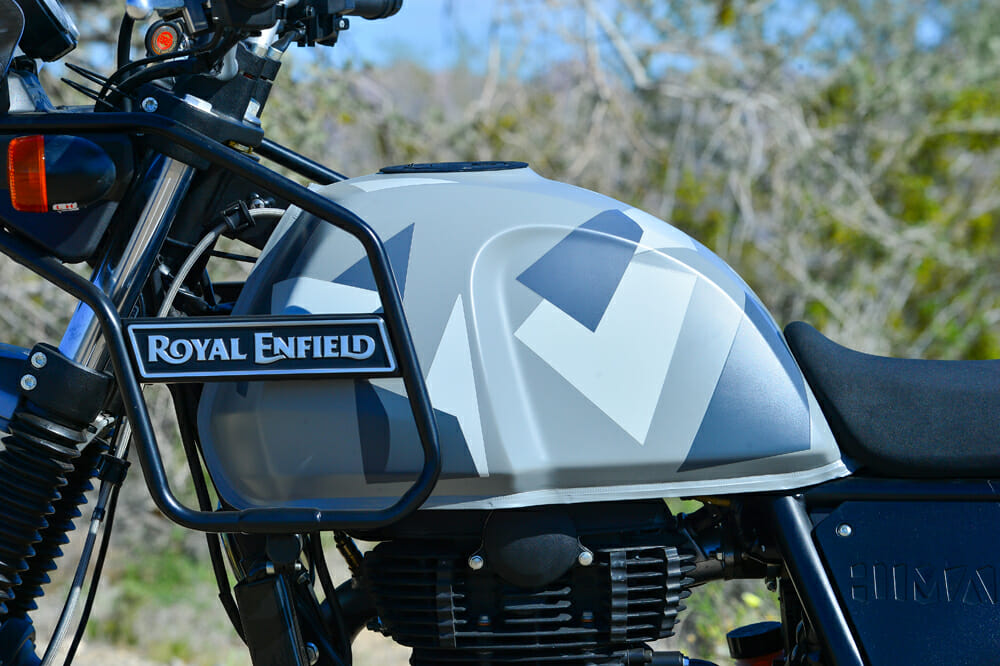 Tank guard also doubles as a place you can strap auxiliary gas cans.
Tank guard also doubles as a place you can strap auxiliary gas cans.
I really like the retro styling and had a lot of positive feedback from people that asked me about the bike. And when people heard that it sells for about $4800, they liked it even more.
If you are looking for a true dual-sport or off-road bike, there are a lot of more capable bikes in a similar price range. However, if you are looking for a do-it-all motorcycle that is comfortable on the road and capable of having fun on dirt roads and the occasional technical terrain, has good fuel range and a distinct classic look, the Himalayan may be just what you are looking for. CN
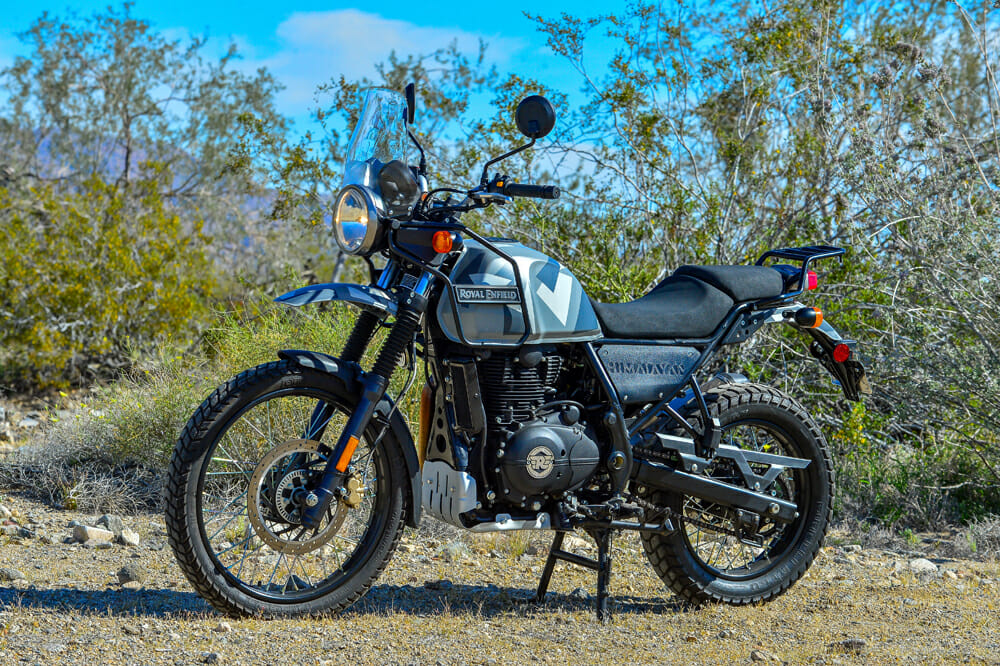
2020 Royal Enfield Himalayan Specifications
|
| MSRP: |
$4749 |
| Engine: |
Air-cooled, 4-stroke, SOHC, single |
| Displacement: |
411cc |
| Bore x stroke: |
78 x 86mm |
| Power (claimed): |
24 hp at 6500 rpm |
| Torque (claimed): |
25 lb-ft at 4500 rpm |
| Fueling: |
EFI |
| Transmission: |
5-speed |
| Clutch: |
Wet multi-disc |
| Chassis: |
Half-duplex split cradle frame |
| Front suspension: |
41mm fork, unadjustable |
| Rear suspension: |
Monoshock, unadjustable |
| Front-wheel travel: |
7.9 in. |
| Rear-wheel travel: |
7.0 in. |
| Front brake: |
Single 300mm disc, 2-piston calipers, ABS |
| Rear brake: |
240mm disc, 1-piston caliper, ABS |
| Front tire: |
Pirelli MT60 90/90-21 in. |
| Rear tire: |
Pirelli MT60 120/90-17 in. |
| Seat height: |
31.5 in. |
| Wheelbase: |
57.6 in. |
| Fuel capacity: |
3.9 gal. |
| Weight (wet, measured): |
430 lbs. |
